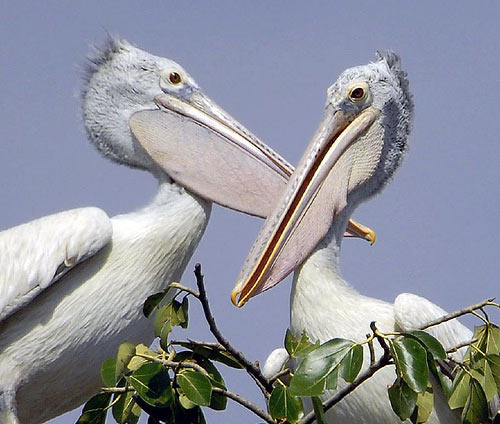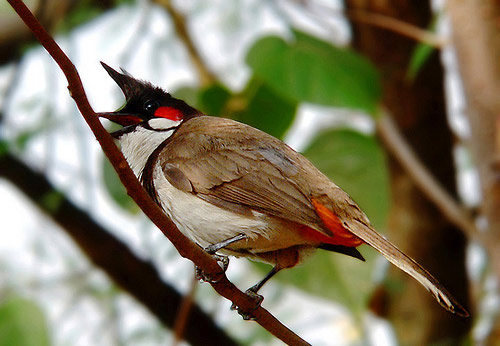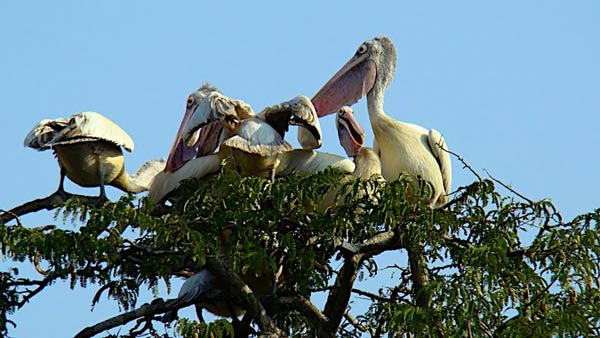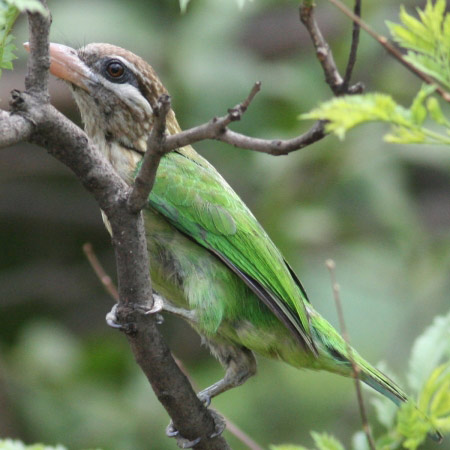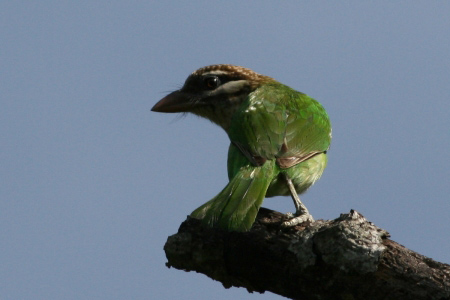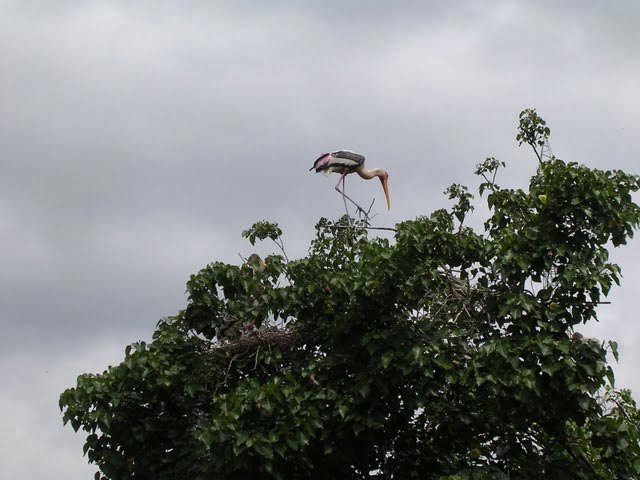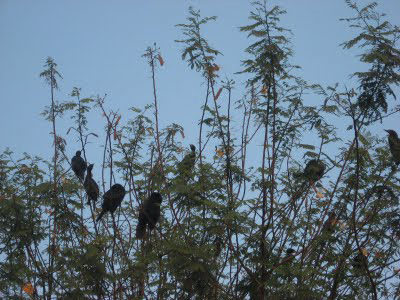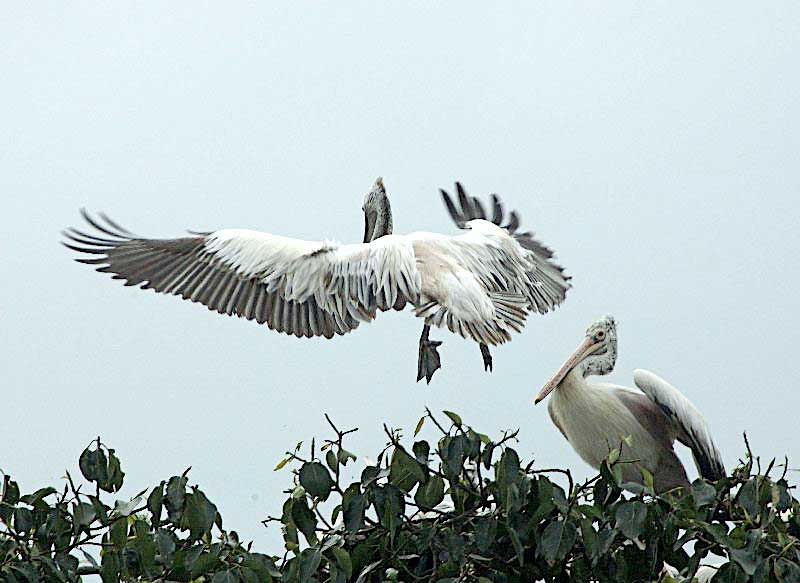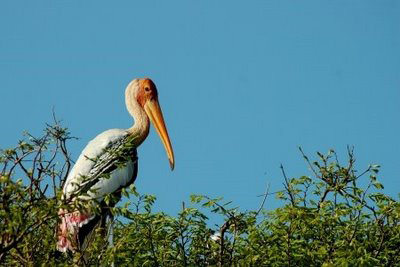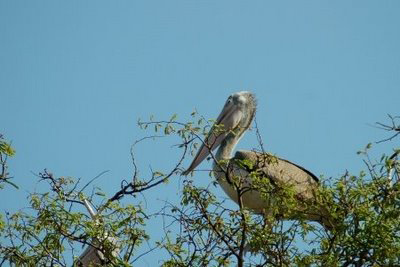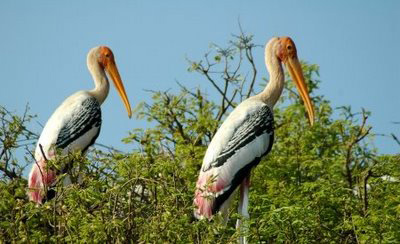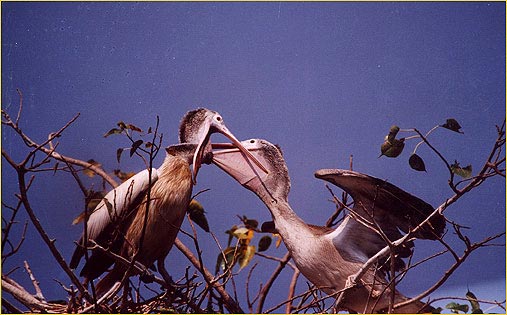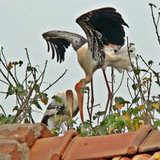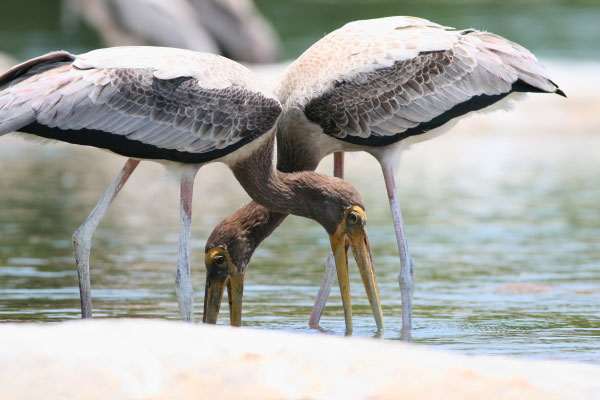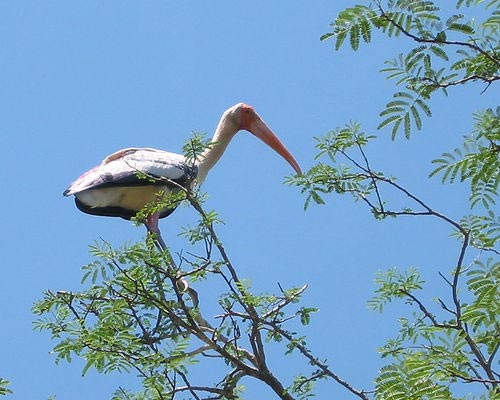Kokkare Belluru
Kokkare Bellur |
About: |
|
Kokkare Bellur (Village of Storks), a small village off the main highway between Bangalore and Mysore, is one of the few nesting sites in India of the spotbilled pelican. In addition, it is also home to hundreds of painted storks. The best time to see the pelicans is in December and January. The place is not a sanctuary, and the storks and pelicans live freely in the trees in the middle of village and are quite used to their human neighbors. Mysore Amateur Naturalists (MAN) have been working with the inhabitants of village to preserve the nesting site of the spotbilled pelicans, which are an endangered species. This is one of those innumerable spots on the Bangalore Mysore highway which can be easily overlooked if you are not aware of the importance of the place. A blushing signboard on the highway which often hides its face from the traveling vehicles doesn't help the matters either. The place is 75 km from Bangalore and 12 km from the highway. After Channapatna, go towards Maddur. Before Maddur, is a village Rudrakshipura. It is just before the BPL factory. Take a left turn here and Kokkare Bellur is another 12 km on this village road. Village of Kokkare Bellur is another haven for migratory birds, as well as bird lovers. This otherwise undescript village springs a surprise with numerous Painted Storks and Pelicans roaming around freely in the village. Best time to visit is around Feb - March and try to make it early morning (as early as 6 - 7). Kokkare Bellur is a short deviation from Bengaluru - Mysuru road. 75 kms from Bengaluru (infact, just after the milestone #75), before the Mysore Mylary hotel, there is a village road towards the left. Kokkare Bellur is abt 12kms from here. Almost half way through, there is a trijuntcion where u shud keep to the right. At Kokkare Bellur just park the vechicle(s) and walk around the village streets with trees on all sides infested with so many beautiful birds! This place offers a rare chance to spot some of the rare birds at very close distances. Yeah ... please remember to keep the silence and not trouble the birds/villagers. |
Location info: |
| Address:About 75 kms from Bangalore |
| District:Mandya |
| Nearest City:Bangalore |
| Best time to visit: October/November, October to march |
Climate/Weather of Kokkare Belluru: |
| The surrounding greenery and absence of pollution often keeps the weather pleasant and the air breathable. |
History of Kokkare Belluru: |
| The Crane is called "kokre" and hence lends its name to a place that these magnificent birds have been visiting for years. |
Interesting things to do: |
Interesting things to Visit in Kokkare Belluru: |
|
Sans the storks, Kokkarebelluru is not exactly a tourist's paradise as there is nothing much to explore. Apart from storks of pristine white hues, you get to see many other colored storks as if some of the birds were bored with this colorless monotony and decided to get a glamorous makeover. If you haven't had your fill of birds, you can try Ranganathittu bird sanctuary as well, where you get to see an amazing variety of birds.
Kokkare bellur, with its cluster of shady trees, a few dozen tiled houses and the simplicity of a rural lifestyle, could well be just another ignominious, wayside village in Karnataka. Come November every year, the branches of the old tamarind and peepal trees are teeming with feathered activity as flocks of Painted Storks and Spot billed Pelicans descend on this hamlet to build their nests and rear their young. The main attraction of Kokkare Bellur is the Painted Stork, which is a familiar sight at marshes and inland waters as it is mainly a fish-eater. The Painted storks are distributed throughout India, Bangladesh, Pakistan, Sri Lanka and Burma. Here you can also find the Spot billed Pelican or Grey Pelican which is a large squat water bird, chiefly grey and grayish white, with short stout legs and large webbed feet. The enormous heavy, flattened bill is underlined throughout its length by an elastic bag of dull purplish skin. Close inspection reveals large blue-back spots along the edge of the upper mandible. They are found in well-watered tracts throughout India, Bangladesh, Pakistan, Sri Lanka and Burma. Both Painted Storks and pelicans are colonial nesters and are known to nest in close proximity. The large tamarind peepal and Portia trees in Kokkare bellur resemble over-populated housing colonies. Standing in their shade you can have a ringside view to the drama of daily chores of these big birds. Each tree has about 20 nests at various levels wedged in different branches. These graceful storks tirelessly glide to and fro, sometimes with a sprig of neem leaves in their bills with which to line their nests, most times with juicy tidbits of fish to thrust down the wide open, pulsating and incessantly screeching throats of their fledglings. The Simsha River and a few other ponds in the vicinity provide the endless supply of fish these waterfowl require during the breeding season. This rare proximity to these waterfowl in their natural habitat makes Kokkare bellur a bird lovers dream and a photographer's paradise. Amateur photography groups from Bangalore and Mysore make regular trips to Kokkare bellur during the breeding season. Even the flesh colored, gawky, fledglings jostling in their nests are so close that there is a strong urge to just reach out ant touch them. And what is more, the big birds themselves are so unselfconscious, displaying a rare confidence that the local villagers, for over four generations, have instilled in them. As for the villagers, these Painted Storks and pelicans have come to be an integral part of their lives. More scientifically, these waterfowl, like most animals, can sense disturbances in nature and skip their breeding cycle in years of sparse rainfall. No wonder then, the farmers dread their non-arrival. And the guano that these birds so generously splatter over the tiled roofs and courtyards is valuable manure. Over the years, though, the number of Spot billed Pelicans and Painted Storks arriving in Kokkare bellur has declined drastically. Naturalists attribute this to the dwindling number of trees and the resulting overcrowding of nests. At Kokkare bellur does not offer much of boarding and lodging facilities, there is just a lone uniformed Forest Guard to justify the Governments recognition of is as a Preserve. But for us city dwellers, for whom even the common house sparrow has become a rarity, Kokkare bellur is a living lesson in mutual trust and confidence between man and bird.
|
Mobile range info: |
How to reach Kokkare Belluru? |
| Nearest Railway Station:The nearest railway is Bangalore |
| Nearest Airport:The nearest Airport is Bangalore International airport. |
|
Road Transport:There are buses from Mandya to Bangalore. The village is located off the Mysore highway, about 75 km from Bangalore. There is a road sign for Kokkare Bellur, but it is easy to miss. The village is 12 km from the main highway. After Channapatna, go towards Maddur. Before Maddur, is a village Rudrakshipura. It is just before the BPL factory. Take a left turn here and Kokkare Bellur is another 12 kms on this village road. Buses You will get buses till Maddur. From there, you can take autos or any other vehicle that you can get in Maddur Other Vehicles You can take other vehicles too. Road Quality The same old story is repeated in varied proportions with all the picnic spots in Bangalore-Mysore highway. The highway is...well, like a true highway. But when you take a turn to meet your destination, it's as if you have left behind all of your good fortune and out to face the hardships of this cruel world, with an unforgiving road for the company.
|
Nearest Visiting places: |
| 1.Ranganathittu 2.Mysore 3.Bandipur National Park |
Nearest Petrol Pump: |
| Petrol Bunk Channapatna |
Hotels/Lodge/Accommodation nearby Kokkare Belluru: |
|
Hari Priya Hotel It is a small village there is no restaurant. Nearest place to eat is Maddur or Cafe Coffee Day/ MTR joint on the way to Bangalore (20 km). There are a couple of hotel in Maddur but the best option is to stay in Bangalore, Srirangapatna or Mysore and make a day trip
|
Things to carry: |
Tips & Suggestions for Kokkare Belluru: |
|
Be there at the right time Well, the best season to visit Kokkarebelluru is between December and January. If you end up in Kokkarebelluru in wrong time, you may not even have crows to show for your efforts. Also, keep some other places on your itinerary too, as it is impossible to spend a whole day at Kokkarebelluru, unless you are a distant relative of Dr. Salim Ali. |
Help Line/Phone Number: |
| Nearest Hospital: Channapatna |
| Society/Community Phone Number |
Kokkare Belluru/Bellur Pelicanry Nearest Attraction |
| Sivasamudram Island |
| About 65kms, East of Mysore, you will find the tiny island town of Shivasamudram in Mandya district. Here the River Cauvery meanders to fall into cascading Shivasamudram Falls. This sparking waterfalls flows through the abundant sylvan forest of Karnataka in Deccan Plateau, plunges 320 feet into gorge into a spate, breaking into a cloud of misty foam. The falls are 893 metres wide.....more |
| Srirangpatnam Island |
| Situated on the Cauvery River, the island-fortress of Srirangapattana is famous as the former capital of the great kings, Hyder Ali, and his son, Tipu Sultan, the 'Tiger of Mysore'. The ruins of the magnificent fortress that stands here is the main tourism attraction.....more |
| Karighatta Temples |
| Karighatta is a hill situated a few kilometres outside the 'island' town of Srirangapatna. It is situated off the Bangalore-Mysore road just before Srirangapatna. The name translates to "Black Hill" in Kannada. The hill has a Hindu temple devoted to a form of Hindu god Vishnu, called "Karigirivasa".....more |
| Melukote Temples |
| Melkote located near Mysore in Karnataka houses an ancient shrine to Vishnu, worshipped as TiruNarayana. This shrine is known for its long standing association with the spiritual leader Ramanujacharya. Melkote is also known as Yadavagiri, yatistalam, Vedadri and Narayanadri. ....more |
| Srirangapatna Temples |
| Srirangapatna also spelt as Srirangapattana, is city of historic, religious, and cultural hub situated in Mandhya district of Karnataka, just about 13kms from Mysore. A must see place on Bangalore- Mysore Highway. Here you will come across the entire town as an island enclosed by River Kaveri.....more |
| Srirangapatna Archeology |
| The river Kaveri surrounds Srirangapatnam , which is 16 km north of Mysore.it was the capital of Muslim Mysore kingdom, which was at loggerhead with the English and the Mysore king.....more |
| Bhimeshwari Sanctuary |
| The sparkling blue waters of Cauvery wind through rocks and ravines and fall off the Deccan Plateau to form the twin falls of Barachukki and Gaganachukki.About 35 kms downstream is yet another set of falls called Mekedatu (Goat's Leap).....more |
| Melukote Wildlife Sanctuary |
| Melkote Temple Wildlife Sanctuary is located in Mandya District of Karnataka and is about 5 km from Melkote. Meant specifically for the protection of wolf, the sanctuary is divided into two blocks, namely, Mudibetta and Narayandurga. Deciduous scrub forest occupies the sanctuary.....more |
| Srirangapatna Historical |
| Srirangapatna also spelt as Srirangapattana, is city of historic, religious, and cultural hub situated in Mandhya district of Karnataka, just about 13kms from Mysore. A must see place on Bangalore- Mysore Highway. Here you will come across the entire town as an island enclosed by River Kaveri.....more |
| Hemagiri Falls |
| This place is located 8 Kms from KR pet enroute to Kikere town or Govindhalli. It is better to take the route back, in view of bad roads on the same stretch to reach Kikere town. The river is in full flow during monsoon and it is a treat to watch.....more |
| Shivasamudram Waterfalls |
| The Shivasamudram falls is a segmented waterfall since the river Cauvery branches into two separate falls - the western falls known as Gaganachukki and the eastern falls, Bharachukki. Shivasamudram falls is the second biggest waterfall in India and the sixteenth largest in the world.....more |
| Bheemeswari River |
| Listen to the sweet hum of the rippling river... Feel the chill of the water... and get to face her majestic beauty by riding down the river in a raft...The Cauvery is one of the most majestic and sacred rivers in the country. Flowing through the thick forests of Karnataka, this river is home to India's only protected fish species - The 'Mahaseer'.....more |
| Mahadevapura River |
| Mahadevapura is located in Mandya district of Karnataka in India. A great picnic spot which is quite far away from modern world. A famous spot for film makers shooting nature scapes -for this hamlet by the Cauvery, offers some of the prettiest frames for any cinematographer.....more |
| Mekedatu River |
| Mekedatu, in Kannada means Goat's leap, which is situated 98kms south of Bangalore. river Cauvery flows into a deep and narrow gorge, so narrow, that a goat could leap over it and that is how it got its name.....more |
| Adichunchanagiri Peacock Sanctuary |
| Located in Mandya District, Adichunchanagiri peacock sanctuary is covered with scrub forest and plantations. The altitude here varies from 770 - 1000 m. The sanctuary was established with the specific purpose of protecting the peacock.....more |
| Krishna Raja Sagara Dam |
| Krishna Raja Sagara also popularly known as KRS is the name of both a lake and the dam that causes it.In 1924[1]. Mokshagundam Visvesvarayya served as the chief engineer. The dam is named for the then ruler of the Mysore Kingdom, Krishnaraja Wodeyar IV.For information about the settlement near the dam and reservoir, see Krishnarajasagara.....more |
| Adi Chunchanagiri Temples |
| ....more |

